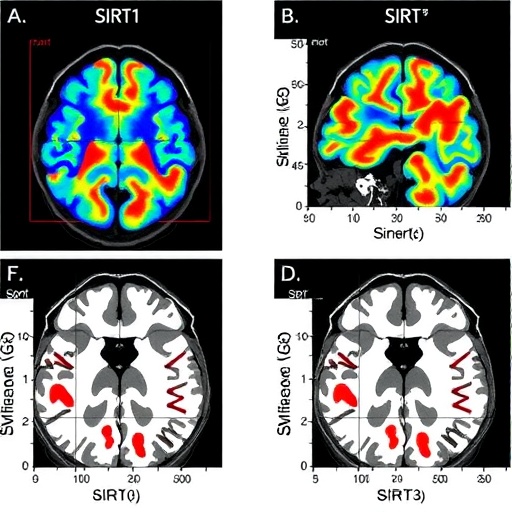In the relentless quest to understand the intricate mechanisms underpinning brain injury and its aftermath, researchers have turned their attention to the molecular guardians known as sirtuins. These proteins, sirtuin 1 (SIRT1) and sirtuin 3 (SIRT3), have emerged as pivotal players in cellular regulation, aging, and neuroprotection. A groundbreaking study, recently published in the International Journal of Legal Medicine, delves into their enigmatic roles within the grim context of fatal traumatic brain injury (TBI). This investigation not only sheds light on the biological upheaval following lethal brain trauma but also pioneers new avenues for forensic and clinical insights.
Traumatic brain injury remains a formidable challenge globally, with millions suffering from its immediate and chronic consequences. Fatal cases, while tragic, provide a unique scientific window into the biochemical chaos unleashed upon impact. The study harnesses this unfortunate reality to unmask the changes in SIRT1 and SIRT3 concentrations found in serum and cerebrospinal fluid (CSF), fluids intimately entwined with brain physiology and pathology. These sirtuins, known for their regulatory functions over mitochondrial activity and oxidative stress responses, could be vital biomarkers post-mortem.
Sirtuins, a family of NAD+-dependent deacetylases, modulate a spectrum of cellular processes, including DNA repair, inflammation, and energy homeostasis. SIRT1 typically resides in the nucleus and cytoplasm, orchestrating gene expression and stress responses. In contrast, SIRT3 localizes predominantly to mitochondria, the cell’s energy powerhouses, exerting control over metabolic enzymes and reactive oxygen species detoxification. The dichotomy and interplay between these two isoforms present a compelling narrative in the context of brain injury, where mitochondrial dysfunction and oxidative damage are rampant.
The research team, led by Łukasz A. Poniatowski and colleagues, undertook a meticulous quantification of SIRT1 and SIRT3 in samples collected from subjects who suffered fatal TBI. Utilizing advanced immunoassays, they measured the concentrations in both serum and CSF shortly after trauma. Their approach allowed for high specificity and sensitivity, crucial for distinguishing subtle changes amid the complex post-injury milieu. Findings from this study contribute significantly to expanding our molecular understanding of brain trauma.
Remarkably, the serum levels of SIRT1 and SIRT3 showed distinct patterns following fatal TBI. SIRT1 concentrations appeared altered in a manner suggesting an acute stress response, possibly reflecting systemic attempts to counteract widespread inflammation and cellular injury. The dynamic seen in serum offers a promising blood-based biomarker angle, which would be invaluable for rapid post-injury diagnostics in clinical and forensic settings.
Parallel assessments in CSF, a fluid bathing the brain and spinal cord, revealed contrasting changes. SIRT3, in particular, demonstrated notable fluctuations, hinting at its mitochondrial-centric role in neuronal survival and injury mitigation. The alterations in CSF concentrations of SIRT3 provide compelling biochemical evidence of mitochondrial distress, a hallmark of severe brain trauma. These insights open possibilities for sirtuin-targeted therapeutics aimed at enhancing mitochondrial resilience post-TBI.
One of the study’s pivotal revelations lies in the ratio and temporal dynamics of SIRT1 to SIRT3 levels. The balance between nuclear/cytoplasmic and mitochondrial sirtuin activity could signify the extent and nature of the brain’s response to trauma. Displacement or dysregulation within these systems might correlate with the injury’s severity or progression, furnishing a diagnostic window into the pathophysiological timeline of fatal brain injury.
From a forensic perspective, the ability to detect and quantify SIRT1 and SIRT3 post-mortem heralds a new frontier for death investigations. Conventional autopsy findings often lack molecular specificity, whereas the inclusion of sirtuin profiles could augment cause-of-death determinations, especially in ambiguous or complex TBI cases. This molecular fingerprinting approach could refine forensic accuracy and enhance legal medicine protocols.
Beyond forensic applications, the study catalyzes broader scientific discourse on neuroprotection and repair mechanisms following brain injury. Sirtuins have long been implicated in aging and neurodegenerative diseases such as Alzheimer’s and Parkinson’s, but their acute role in trauma has been less clear. Demonstrating their modulation in fatal TBI contexts bridges this gap and paves the way for novel therapeutic strategies.
Critically, therapeutic modulation of sirtuins—via activators or inhibitors—has been proposed in myriad pathologies. The findings here underscore the potential of targeting SIRT1 and SIRT3 to ameliorate secondary brain injury processes such as oxidative stress, inflammation, and mitochondrial failure. Pharmacological interventions aiming to stabilize or boost sirtuin activity could represent a transformative direction in acute TBI treatment paradigms.
The study also calls attention to the importance of timing in biomarker analysis post-injury. The temporal expression patterns of SIRT1 and SIRT3 may reflect different stages of cellular damage and repair, essential information for correctly interpreting molecular data in both clinical and post-mortem scenarios. Future investigations focusing on longitudinal sampling will further elucidate these dynamics.
Methodologically, the research surmounts challenges related to fluid sample integrity and protein stability, vital considerations when working with post-mortem specimens. The robust experimental design and clear analytical methodologies ensure the reliability of the sirtuin measurements, setting a high standard for subsequent investigations in this domain.
In sum, the evaluation of SIRT1 and SIRT3 in serum and cerebrospinal fluid post-fatal traumatic brain injury offers a compelling molecular perspective on the devastating consequences of brain trauma. This work not only advances scientific knowledge but also heralds practical implications for forensic medicine, clinical diagnostics, and potential therapeutic development. The delineation of sirtuin alterations paves the way for an era where molecular signatures complement traditional anatomical and histological assessments in TBI.
As the field of neurotrauma research evolves, integrating molecular biology with clinical and forensic practice remains a paramount goal. This study’s insights into sirtuin dynamics symbolize a significant stride toward deciphering the biochemical aftermath of brain injury with unprecedented clarity. Future research building on these findings may one day transform how we diagnose, treat, and ultimately prevent the lethal consequences of traumatic brain injuries.
Subject of Research: Traumatic brain injury; Molecular biomarkers; Sirtuin proteins (SIRT1, SIRT3); Post-mortem analysis.
Article Title: Evaluation of Sirtuin 1 (SIRT1) and Sirtuin 3 (SIRT3) in serum and cerebrospinal fluid following fatal traumatic brain injury.
Article References:
Poniatowski, Ł.A., Siwińska, A., Kwiatkowska, M. et al. Evaluation of Sirtuin 1 (SIRT1) and Sirtuin 3 (SIRT3) in serum and cerebrospinal fluid following fatal traumatic brain injury. Int J Legal Med (2025). https://doi.org/10.1007/s00414-025-03626-8
Image Credits: AI Generated
Tags: aging and brain injury recoverybiochemical changes after brain injurybiomarkers for fatal brain traumacellular responses to traumatic brain injurycerebrospinal fluid analysis in TBIforensic implications of brain injury researchinternational journal of legal medicine studiesmolecular mechanisms of brain injuryNAD+-dependent deacetylases and brain healthoxidative stress in traumatic brain injuryrole of sirtuins in neuroprotectionSIRT1 and SIRT3 in traumatic brain injury






